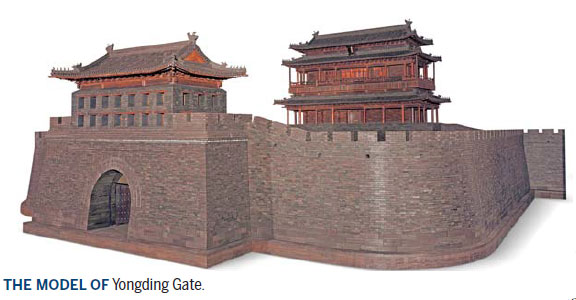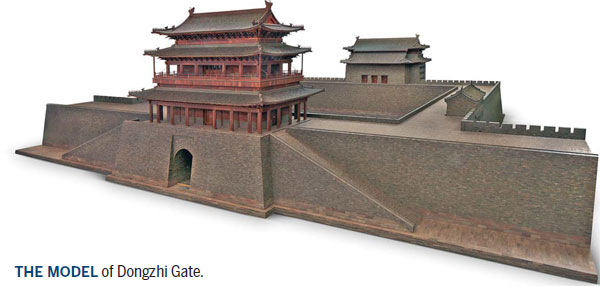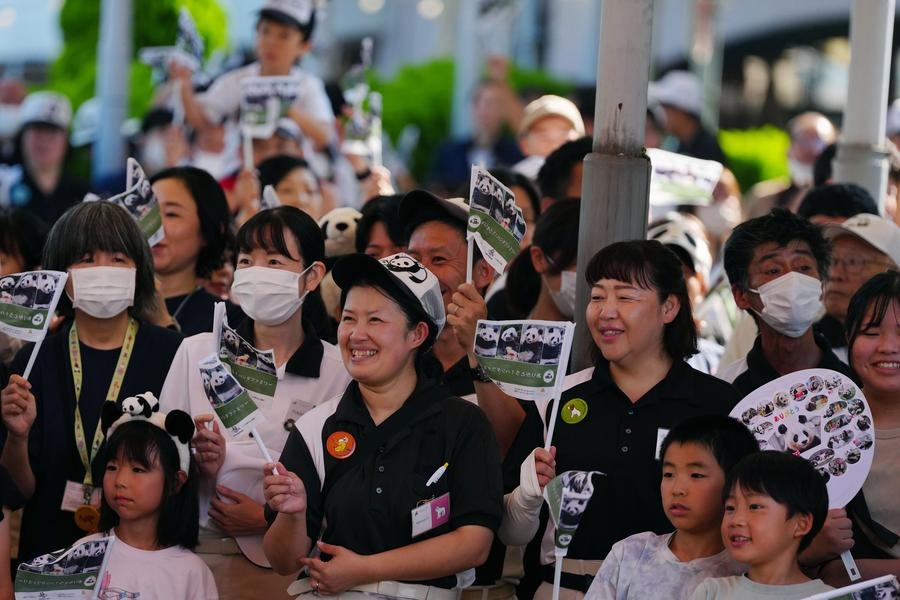Towering ambition

Billionaire Chan Laiwa has recreated the glorious city walls and watchtowers that have long disappeared from Beijing
When the sun was barely over the horizon on May 6, a crowd had already gathered outside the gate of the China Red Sandalwood Museum in east Beijing, ready to witness the unveiling of a project that can be traced back some 600 years.
At the front is a replica of Zhengyang Gate. At 18 meters by 17.2 meters and 5 meters tall, it's one-10th the size of the original, and instead of bricks and stones it has red sandalwood for the main buildings and Yinchen wood for the wall, materials often used for collectible furniture.
| Chan Laiwa visits the craftspeople working on a red sandalwood piece at a workshop of the Red Sandalwood Museum in Beijing. Photos Provided to China Daily |
The gate's original watchtower still stands to the south of Tian'anmen Square, but the surrounding structures, including an arrow tower and a barbican, have long vanished.
Zhengyang is one of the 16 gates that formed the inner and outer circles of the old Beijing wall that Chan Laiwa, founder and curator of the museum, has recreated. It's a project that took six years, 100 top craftsmen and an untold amount of money.
"Of the 1.3 billion or so who make up China's population, probably fewer than 100 million have seen Beijing's city wall," Chan says. "We wanted to absorb and reflect their sense of awe when they recall their experiences with the original structures. We wanted to capture that collective memory."
Beijing's fortifications were built in the 15th and 16th centuries. The inner city wall was 24 kilometers long and 15 meters high, and it had nine gates. The outer city walls had a perimeter of 28 km, with seven gates.
Edmond Bacon, an architect from the United States, once described the city wall as "man's greatest single architectural achievement".
Unfortunately, much of the city wall was dismantled in the 20th century, particularly during the political turmoil of the 1950s to the '70s. Only some isolated remnants are now visible.
"I grew up in Beijing and as a child got to see some sections of the wall. It's a fond memory," recalls Chan, a self-made billionaire.

At the unveiling ceremony, Shan Jixiang, curator of the Forbidden City (officially the Palace Museum), gave a vivid summary of the city's history.
Humans began living in the place we now call Beijing as early as 500,000 years ago, he says. A city came into shape 3,000 years ago, and it first became a capital 800 years ago. Most people have learned about its history through the Forbidden City and the old city walls.
"The Forbidden City is still here, but the wall, with its gates and watchtowers, is gone," Shan says. "It has yielded to the subway and a ring road. Most old Beijingers have fond memories of the wall, and now the replicas are a reminder of their cultural history."
No small effort
Since the replicas are in miniature, some may question their value. However, Lyu Zhangshen, curator of the National Museum of China, who majored in architecture, says: "These are exquisite replicas of great architecture that can be called art. From the choice of material to the level of craftsmanship, Chan's models evoke the beauty of the original structures and exhibit the finesse of the carvings."
The National Museum has already agreed to display replicas of Anding Gate and the Temple of Heaven prayer hall.
As many of the real structures were destroyed only in the past century, graphic records are in abundance. Details that were undocumented were inferred because the Ming (1368-1644) and Qing (1644-1911) dynasties followed strict construction protocols.
On top of that, everything in the museum was handcrafted by experts in the field.
Material matters
Red sandalwood, known for its slow growth and rarity, is highly valued in China. Chan says she was heartbroken when she saw some of the furniture made from this lumber destroyed in political movements and committed to restore them.
Early in her endeavor, she invited the Forbidden City's top experts to visit her workshop. "They didn't even look at me, let alone shake my hand," she recalls. However, after they saw what she had already done, they gave her a hug, a rare gesture in Chinese culture, and offered her a pass into the Forbidden City warehouses to make copies from the originals.
Shan says that although his museum has the largest collection of Ming and Qing furniture, the 6,200 pieces are stored in 30 warehouses and rarely see the light of day.
"We don't have that much space for display, so Chan's museum makes up for what we lack by showing these wonderful replicas to the public," he says.
Chan's decision to create the replicas with red sandalwood and Yinchen wood raised the stakes significantly, as the two are rare and expensive. Red sandalwood tends to become hollow as it grows, while Yinchen wood was chosen for its matching color with the wall bricks.
"We bought lots of them, but could use only a small portion for carving," she says.
Yan Chongnian, a historian specializing in the Qing Dynasty who was consulted by the Red Sandlewood Museum, says the cost to make just one watchtower was about $15 million.
Work to build the original architecture started in 1403 and took 20 years. Chan's project has lasted six years, he adds.
"She's dedicated to the preservation of traditional Chinese culture," he says of Chan. "Some of the rich love to flaunt their wealth through vulgar means, but she uses hers for this purpose. That is a great virtue."
Liu Dake, a scholar in ancient architecture and conservation, describes the project as Chan's greatest legacy: "This will be associated with her because future generations will be able to get a sense of the greatness of this old city. If you build one gate, it's just a gate; but if you build 16, you'll have mapped out a whole city."
Chan is now talking with the city government about building another museum in the eastern suburb of Tongzhou.
"I envision the busy shopping street outside Zhengyang Gate or even boats in the moat and river system. I want everyone to be proud of the city of Beijing," she says.
raymondzhou@chinadaily.com.cn


(China Daily European Weekly 07/02/2016 page21)
Today's Top News
- Flexible programs build diverse talent pool
- China opposes deals harming its interests
- CPC's governance highly effective and democratic
- Canada urged to stop politicizing economic issues
- Xi calls for upholding of ethnic unity
- Abuse of 'security' stifles innovation, collaboration































